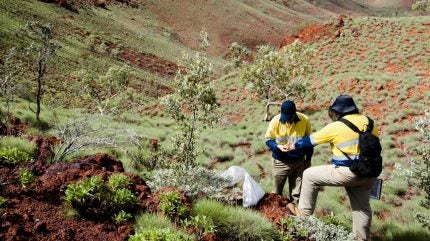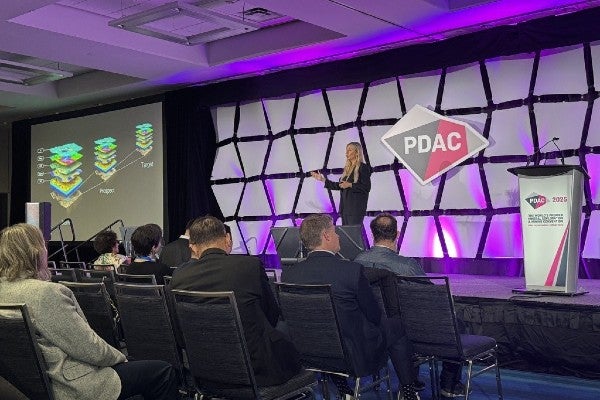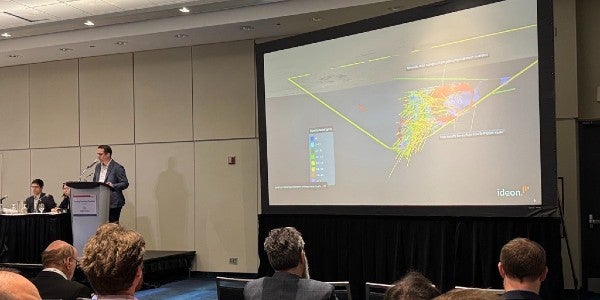
In the face of cost pressures and dwindling resources, the mining industry is turning to new technology that can enhance minerals prospecting and exploration.
“There are a lot of new technologies around to help speed up exploration ─ geophysical methods, AI, hyperspectral analysis ─ but you still need that physical drilling,” says Haydn Daxter, CEO of Power Metals, which is exploring and developing caesium, lithium and tantalum projects in Canada.

Discover B2B Marketing That Performs
Combine business intelligence and editorial excellence to reach engaged professionals across 36 leading media platforms.
As deposits get more difficult to identify, new imaging technology – combined with AI – is gaining traction.
“More and more the industry is recognising that targets are harder to find – because they are either under cover or at greater depths,” explains Jonathan Rudd, president of Dias Geophysical, a Canada-based company that offers geophysical surveys to the mining industry. “I believe that technologies that can characterise the subsurface to greater depths are the ones that are going to make the difference,” says Rudd.
Once data has been collected, it must be used wisely, meaning integration with geology, geochemistry and other datasets is key. “AI is certainly an area that adds value to that,” Rudd continues.
This sentiment is echoed by others that are leveraging AI to support minerals discovery and exploration.

US Tariffs are shifting - will you react or anticipate?
Don’t let policy changes catch you off guard. Stay proactive with real-time data and expert analysis.
By GlobalData“Artificial intelligence, particularly AI agents, play a crucial role in mining, from discovery to exploration,” Alex Boucher, vice-president at Seequent Labs tells Mining Technology.
Seequent recently launched a new cloud-based geoscience data platform, Seequent Evo, that aims to address the challenge of managing vast amounts of information in siloes or walled-gardens.
“Centralising data improves collaboration through data management, geospatial search and 3D visualisation, ensuring decision-makers have access to current information,” Boucher adds.
AI’s role in mineral exploration
The use of AI is increasing in minerals prospecting and exploration across a range of technologies.
More than half of respondents to a recent GlobalData survey identified AI-driven exploration and resource evaluation as the top focus area for mining investment over the next five years.
AI can help mining companies analyse large volumes of geological data, satellite imagery and historical records to identify potential mineral deposits. It can also be used to gain knowledge and understanding of the terrain and to map it out with greater precision than is possible by human effort alone, according to GlobalData, Mining Technology’s parent company.
Additionally, pattern matching and predictive analysis can be combined with AI to analyse large amounts of geological data to reveal the most likely locations of mineral resources.
Machine learning (ML) algorithms can also detect patterns, anomalies and indicators of mineralisation, assisting in more efficient exploration and target selection.
“In mining what you have is a lot of siloed data that has been collected over years and in many cases decades; AI has the ability to bring that data together,” says Gary Agnew, CEO and co-founder of Ideon Technologies.
Taking a data-driven approach to exploration
The industry appetite for AI aligns with calls from industry leaders to accelerate adoption of the technology.
Flavia Tata Nardini, CEO and co-founder of Australia-based Fleet Space Technologies, used her keynote address at the PDAC convention on 4 March to call on the industry to shift its mindset towards more data-driven minerals exploration.

Today there is “too much gambling” instead of really looking into the data, Nardini claims.
Her company leverages satellite connectivity, 3D multiphysics data (collected from seismic sensors) and AI as part of its ExoSphere minerals exploration technology. The company has worked with mining giants such as Rio Tinto, Gold Fields and Barrick on minerals exploration efforts.
“If you work in this world, you are running a data insight business,” Nardini said during her talk. She also implored mining execs to “create a team of software engineers or data scientists that have worked with AI” to drive innovation.
Fleet Space is one of several companies that leverage AI in mineral discovery. Start-up KoBold Metals, which is backed by both Bill Gates and Jeff Bezos, has so-far amassed $1bn in total funding to support its AI-driven approach to minerals exploration.
Hyperspectral imaging gains traction
Hyperspectral imaging was another technology in the spotlight at PDAC, garnering a mention during a keynote presentation by Mike Henry, CEO of BHP.
Henry said that applying new technologies from other sectors, including 3D seismic sensors and muon tomography, could support exploration at greater depths or in underexplored regions of Canada.
BHP is already working with Ideon Technologies on an imaging programme using panel muon detectors at the Olympic Dam underground mine in South Australia.
Ideon’s CTO and co-founder Doug Schouten presented a case study at PDAC illustrating how muon tomography is being used to map a 6km area, around 1km below the surface in an area of busy active mining.
The muon data collected showed good conformance to BHP block models for areas with extensive drill data but also identified a “high-density structure”, which represents an interesting drill target in an area with no prior drilling.

In the snow-covered Yukon region of Canada, Ideon has used its high-resolution muon imaging and AI technology to identify new drill targets for Fireweed Metals within the Macmillan Pass district.
Despite the harsh weather, Fireweed was able to gain “actionable intelligence in real time from an imaging solution passively collecting data at site during the off-season”, according to Jack Milton, vice-president of geology at Fireweed.
Agnew says that the solution is helping companies accelerate the time to discovery “by 50% or more”, at a lower cost and with greater confidence.
Power Metals has also run trials using hyperspectral analysis to predict gold occurrence at a project in Canada. Daxter says the trial “worked well”, although adoption may be slowed by tight exploration schedules as well as industry scepticism around embracing new technology.
Challenges in adoption of new exploration tech
Industry reluctance to embrace innovation is seen as a primary barrier to adoption of technology such as AI in minerals exploration.
“Due to the way codes are set up for establishing mineral resources, both in Australia and in Canada, a lot of traditional drilling is needed,” says Chris Evans, managing director of Winsome Resources, owner of several Canadian lithium projects.
He adds that even if a technology could map out exactly what an orebody looks like, no investor is likely to commit hundreds of millions of dollars to a project without drill results.
However, industry reluctance to embrace technology could be changing, with Agnew pointing to rapid adoption of autonomous vehicles by miners over the past decade.
Nevertheless, issues related to data integration need to be addressed if the mining industry is to widely embrace tech such as AI.
“The biggest barrier to adopting emerging technologies is overcoming the industry’s existing product and information silos,” says John Vandermay, CTO at Seequent. “Mining operations are often reliant on a variety of legacy systems and proprietary tools that do not communicate well with each other. This can create integration challenges and make it difficult for organisations to fully embrace new technology.”
A related challenge stems from the complexity of managing large-scale datasets.
“Having a data set that is relevant and that can be merged with other packages that you can use for your own benefit is still a work in progress for a lot of companies,” says Daxter.
Evans points out that Winsome has spent $100m over the past three years, mostly on drilling – or “just data” that still needs to be analysed.
Boucher emphasises that ML and geoscience modelling are essential to accelerating mineral discovery because they allow hidden patterns to be uncovered within large datasets.
“The mining industry needs to adapt by embracing new workflows and rapidly evolving technologies, such as artificial intelligence and machine learning,” he adds.
“This kind of adaptability will be crucial for the mining industry as it seeks to stay competitive in a rapidly changing technological landscape.”





